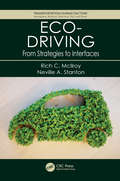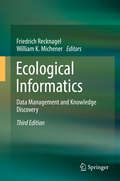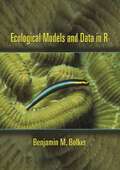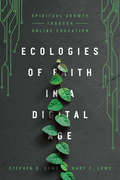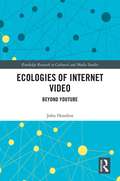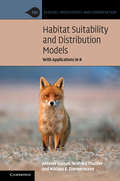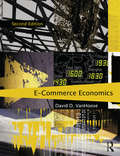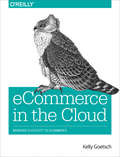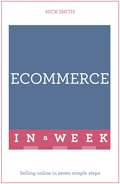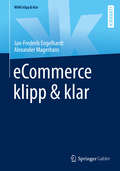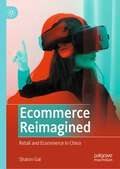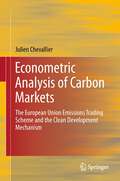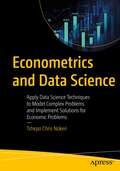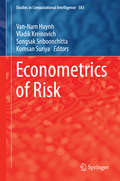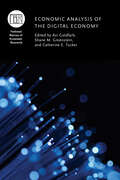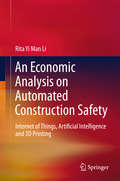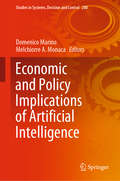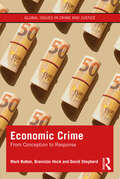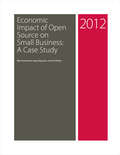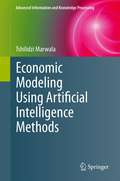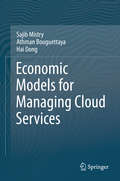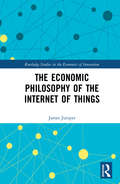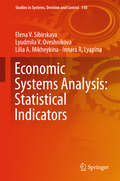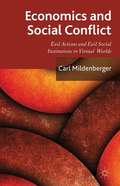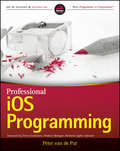- Table View
- List View
Eco-Driving: From Strategies to Interfaces (Transportation Human Factors)
by Rich C. Mcllroy Neville A. StantonEco-driving has the potential to save fuel and reduce emissions without having to make any changes to vehicles or road infrastructure. This book provides an in-depth understanding of the contemporary issues in the human factors aspects of eco-driving strategies and interfaces and the effects on driver behaviour. A review of the literature concerning design, behaviour, and energy use led to an exploration of Ecological Interface Design, and the Skills, Rules, and Knowledge (SRK) taxonomy of human behaviour, particularly with regard to haptic information presented through the accelerator pedal. This book explains that eco-driving can be performed by anyone in control of a vehicle.
Ecological Informatics
by Friedrich Recknagel William K. MichenerEcological Informatics is defined as the design and application of computational techniques for ecological analysis, synthesis, forecasting and management. The book provides an introduction to the scope, concepts and techniques of this newly emerging discipline. It illustrates numerous applications of Ecological Informatics for stream systems, river systems, freshwater lakes and marine systems as well as image recognition at micro and macro scale. Case studies focus on applications of artificial neural networks, genetic algorithms, fuzzy logic and adaptive agents to current ecological management issues such as toxic algal blooms, eutrophication, habitat degradation, conservation of biodiversity and sustainable fishery
Ecological Models and Data in R
by Benjamin M. BolkerEcological Models and Data in R is the first truly practical introduction to modern statistical methods for ecology. In step-by-step detail, the book teaches ecology graduate students and researchers everything they need to know in order to use maximum likelihood, information-theoretic, and Bayesian techniques to analyze their own data using the programming language R. Drawing on extensive experience teaching these techniques to graduate students in ecology, Benjamin Bolker shows how to choose among and construct statistical models for data, estimate their parameters and confidence limits, and interpret the results. The book also covers statistical frameworks, the philosophy of statistical modeling, and critical mathematical functions and probability distributions. It requires no programming background--only basic calculus and statistics. Practical, beginner-friendly introduction to modern statistical techniques for ecology using the programming language R Step-by-step instructions for fitting models to messy, real-world data Balanced view of different statistical approaches Wide coverage of techniques--from simple (distribution fitting) to complex (state-space modeling) Techniques for data manipulation and graphical display Companion Web site with data and R code for all examples
Ecologies of Faith: Spiritual Growth through Online Education
by Stephen D. Lowe Mary E. LoweMany Christian institutions have embraced new technologies, especially online education. But is it possible for us to grow spiritually through our digital communities? Steve Lowe and Mary Lowe, longtime proponents of online education, trace the motif of spiritual growth through Scripture and consider how students and professors alike might foster digital ecologies in which spiritual transformation can take place.
Ecologies of Internet Video: Beyond YouTube (Routledge Research in Cultural and Media Studies)
by John HondrosThis book explores the complex, dynamic, and contested webs of relationships in which three different groups of video makers found themselves when distributing their work on the Internet. It draws upon both the Deleuzian notion of "assemblage" and Actor-Network Theory, which together provide a rich conceptual framework for characterizing and analysing these webs. The groups examined are a UK video activist project, a community of film and television fans originating in the US, and an association of US community television producers. Rather than taking YouTube as its point of departure, this book centres on the groups themselves, contextualizing their contemporary distribution practices within their pre-Internet histories. It then follows the groups as they drew upon various Internet technologies beyond YouTube to create their often-complex video distribution assemblages, a process that entangled them in these webs of relationships. Through the analysis of detailed ethnographic fieldwork conducted across a period of several years, this book demonstrates that while the groups found some success in achieving their various goals as video makers, their situations were often problematic and their agency limited, with their practices contested by both human and technological actors within their distribution assemblages.
Ecology, Biodiversity and Conservation: With Applications in R (Ecology, Biodiversity and Conservation)
by Antoine Guisan Wilfried Thuiller Di Cola Valeria Damien Georges Zimmermann Niklaus E. Psomas Achilleas Niklaus E. Achilleas PsomasThis book introduces the key stages of niche-based habitat suitability model building, evaluation and prediction required for understanding and predicting future patterns of species and biodiversity. Beginning with the main theory behind ecological niches and species distributions, the book proceeds through all major steps of model building, from conceptualization and model training to model evaluation and spatio-temporal predictions. Extensive examples using R support graduate students and researchers in quantifying ecological niches and predicting species distributions with their own data, and help to address key environmental and conservation problems. Reflecting this highly active field of research, the book incorporates the latest developments from informatics and statistics, as well as using data from remote sources such as satellite imagery. A website at www. unil. ch/hsdm contains the codes and supporting material required to run the examples and teach courses.
eCommerce Economics, Second Edition
by David VanHooseThis second edition of eCommerce Economics addresses the economic issues associated with using computer-mediated electronic networks, such as the Internet, as mechanisms for transferring ownership of or rights to use goods and services. After studying this book, students will recognize problems that arise in the electronic marketplace, such as how to gauge the competitive environment, what products to offer, how to market those products, and how to price those products. They also will understand the conceptual tools required to evaluate the proper scope of public policies relating to electronic commerce. Core topics covered in the book include the underpinning of electronic commerce and the application of basic economic principles, including the theories of perfect and imperfect competition, to the electronic marketplace. Building on this foundation, the book discusses virtual products, network industries, and business strategies and conduct. Additional key topics include Internet advertising, intellectual property rights in a digital environment, regulatory issues in electronic markets, public sector issues, online banking and finance, digital cash, international electronic trade, and the implications of e-commerce for aggregate economic activity.
eCommerce in the Cloud
by Kelly GoetschIs your eCommerce solution ready for the cloud? This practical guide shows experienced and aspiring web architects alike how to adopt cloud computing incrementally, using public Infrastructure-as-a-Service and Platform-as-a-Service. You will learn how to marshal as much capacity as you need to handle peak holiday or special-event traffic.Written by eCommerce expert Kelly Goetsch, this book helps architects leverage recent technological advances that have made it possible to run an entire enterprise-level eCommerce platform from a cloud.Explore cloud service models: Infrastructure-as-a-Service, Platform-as-a-Service, and Software-as-a-ServiceLearn about public, hybrid, and private cloud deployment modelsUnderstand the impact of omnichannel retailing on platform and deployment architecturesBuild an auto-scaling solution that can quickly add or subtract hardware in response to real-time trafficRe-apply what you already know about security to the cloudRun a single eCommerce platform from multiple data centers, including several forms of multi-masterBuild a hybrid solution or deploy your entire platform to the cloudLearn application and deployment architecture for "cloud native" through legacy eCommerce platformsUse Software-as-a-Service for eCommerce, including Content Delivery Networks and Global Site Load Balancing services
eCommerce In A Week: Selling Online In Seven Simple Steps
by Nick SmithIn today's working environment, which is changing faster than ever, e-commerce is more than a buzzword. It is a vital skill to help you survive and get ahead in your career. Digital marketing consultant Nick Smith has been there and done it, and in this short, accessible book he shares a lifetime of hard-earned wisdom and practical advice.Sunday: Getting ready to start your storeMonday: Basic e-commerce setupTuesday: Social marketing for e-commerceWednesday: Pay-per-click (PPC) marketing for e-commerceThursday: Search engine optimization (SEO) for e-commerceFriday: Customer service for e-commerceSaturday: Bringing it all together into the ultimate e-commerce marketing system
eCommerce klipp & klar (WiWi klipp & klar)
by Jan-Frederik Engelhardt Alexander MagerhansDieses Lehrbuch präsentiert eine Einführung und Vertiefung der wesentlichen Themenfelder des eCommerce. Der Fokus liegt dabei auf kundenzentrierten Aspekten, wie z.B. der Kundenzufriedenheit und -erwartung. Diese werden entlang einer Customer Journey systematisiert und ausgeführt. Neben Themen wie dem Kundenmanagement wird vor allem auch auf Onlineshops im eCommerce, insbesondere auf deren Gestaltungsmöglichkeiten, eingegangen. Dabei wird aufgezeigt, wie eine logische Wertschöpfung nach Gesetzen der Netzökonomie aussehen kann. Schließlich zeigen die Autoren die Erfolgsfaktoren des eCommerce auf, für die die bestmögliche Kenntnis des Kunden eine wesentliche Grundlage bildet. Das praxisorientierte Buch richtet sich an Studierende und auch Praktiker, die den eCommerce in Ihrem Unternehmen aktiv gestalten und entwickeln.
Ecommerce Reimagined: Retail and Ecommerce in China
by Sharon GaiThis book offers a practical guide to Chinese ecommerce markets for businesspeople and scholars. China represents a $5.6 trillion retail market, with the highest ecommerce penetration rate in the world. Due to the COVID-19 pandemic, brands are investing more in growing online sales. Written from the heart of the world’s largest e-commerce platform, Ecommerce Reimagined: Retail and Ecommerce in China is a book that aims to satisfy the growing need of entrepreneurs and businesses hoping to tap into China’s market and provide context to students and academics who post an interest in learning about how ecommerce has shaped the Chinese retail space.
Econometric Analysis of Carbon Markets: The European Union Emissions Trading Scheme and the Clean Development Mechanism
by Julien ChevallierThrough analysis of the European Union Emissions Trading Scheme (EU ETS) and the Clean Development Mechanism (CDM), this book demonstrates how to use a variety of econometric techniques to analyze the evolving and expanding carbon markets sphere, techniques that can be extrapolated to the worldwide marketplace. It features stylized facts about carbon markets from an economics perspective, as well as covering key aspects of pricing strategies, risk and portfolio management.
Econometrics and Data Science: Apply Data Science Techniques to Model Complex Problems and Implement Solutions for Economic Problems
by Tshepo Chris NokeriGet up to speed on the application of machine learning approaches in macroeconomic research. This book brings together economics and data science.Author Tshepo Chris Nokeri begins by introducing you to covariance analysis, correlation analysis, cross-validation, hyperparameter optimization, regression analysis, and residual analysis. In addition, he presents an approach to contend with multi-collinearity. He then debunks a time series model recognized as the additive model. He reveals a technique for binarizing an economic feature to perform classification analysis using logistic regression. He brings in the Hidden Markov Model, used to discover hidden patterns and growth in the world economy. The author demonstrates unsupervised machine learning techniques such as principal component analysis and cluster analysis. Key deep learning concepts and ways of structuring artificial neural networks are explored along with training them and assessing their performance. The Monte Carlo simulation technique is applied to stimulate the purchasing power of money in an economy. Lastly, the Structural Equation Model (SEM) is considered to integrate correlation analysis, factor analysis, multivariate analysis, causal analysis, and path analysis.After reading this book, you should be able to recognize the connection between econometrics and data science. You will know how to apply a machine learning approach to modeling complex economic problems and others beyond this book. You will know how to circumvent and enhance model performance, together with the practical implications of a machine learning approach in econometrics, and you will be able to deal with pressing economic problems. What You Will LearnExamine complex, multivariate, linear-causal structures through the path and structural analysis technique, including non-linearity and hidden statesBe familiar with practical applications of machine learning and deep learning in econometricsUnderstand theoretical framework and hypothesis development, and techniques for selecting appropriate modelsDevelop, test, validate, and improve key supervised (i.e., regression and classification) and unsupervised (i.e., dimension reduction and cluster analysis) machine learning models, alongside neural networks, Markov, and SEM modelsRepresent and interpret data and models Who This Book Is ForBeginning and intermediate data scientists, economists, machine learning engineers, statisticians, and business executives
Econometrics of Risk
by Van-Nam Huynh Vladik Kreinovich Songsak Sriboonchitta Komsan SuriyaThis edited book contains several state-of-the-art papers devoted to econometrics of risk. Some papers provide theoretical analysis of the corresponding mathematical, statistical, computational, and economical models. Other papers describe applications of the novel risk-related econometric techniques to real-life economic situations. The book presents new methods developed just recently, in particular, methods using non-Gaussian heavy-tailed distributions, methods using non-Gaussian copulas to properly take into account dependence between different quantities, methods taking into account imprecise ("fuzzy") expert knowledge, and many other innovative techniques. This versatile volume helps practitioners to learn how to apply new techniques of econometrics of risk, and researchers to further improve the existing models and to come up with new ideas on how to best take into account economic risks.
Economic Analysis of the Digital Economy (National Bureau of Economic Research Conference Report)
by Catherine E. Tucker Avi Goldfarb Shane M. GreensteinAs the cost of storing, sharing, and analyzing data has decreased, economic activity has become increasingly digital. But while the effects of digital technology and improved digital communication have been explored in a variety of contexts, the impact on economic activity--from consumer and entrepreneurial behavior to the ways in which governments determine policy--is less well understood. Economic Analysis of the Digital Economy explores the economic impact of digitization, with each chapter identifying a promising new area of research. The Internet is one of the key drivers of growth in digital communication, and the first set of chapters discusses basic supply-and-demand factors related to access. Later chapters discuss new opportunities and challenges created by digital technology and describe some of the most pressing policy issues. As digital technologies continue to gain in momentum and importance, it has become clear that digitization has features that do not fit well into traditional economic models. This suggests a need for a better understanding of the impact of digital technology on economic activity, and Economic Analysis of the Digital Economy brings together leading scholars to explore this emerging area of research.
An Economic Analysis on Automated Construction Safety
by Rita Yi LiThis book addresses information technologies recently applied in the field of construction safety. Combining case studies, literature reviews and interviews to study the issue, it presents cutting-edge applications of various information technologies (ITs) in construction in different parts of the world, together with a wealth of figures, tables and examples. Though primarily intended for researchers and experts in the field, the book will also benefit graduate students.
Economic and Policy Implications of Artificial Intelligence (Studies in Systems, Decision and Control #288)
by Domenico Marino Melchiorre A. MonacaThis book presents original research articles addressing various aspects of artificial intelligence as applied to economics, law, management and optimization. The topics discussed include economics, policies, finance, law, resource allocation strategies and information technology. Combining the input of contributing professors and researchers from Italian and international universities, the book will be of interest to students, researchers and practitioners, as well as members of the general public interested in the economic and policy implications of artificial intelligence.
Economic Crime: From Conception to Response (Global Issues in Crime and Justice)
by Mark Button Branislav Hock David ShepherdThis book is the first attempt to establish 'economic crime' as a new sub-discipline within criminology. Fraud, corruption, bribery, money laundering, price-fixing cartels and intellectual property crimes pursued typically for financial and professional gain, have devastating consequences for the prosperity of economic life. While most police forces in the UK and the USA have an ‘economic crime’ department, and many European bodies such as Europol use the term and develop strategies and structures to deal with it, it is yet to grain traction as a widely used term in the academic community. Economic Crime: From Conception to Response aims to change that and covers: definitions of the key premises of economic crime as the academic sub-discipline within criminology; an overview of the key research on each of the crimes associated with economic crime; public, private and global responses to economic crime across its different forms and sectors of the economy, both within the UK and globally. This book is an essential resource for students, academics and practitioners engaged with aspects of economic crime, as well as the related areas of financial crime, white-collar crime and crimes of the powerful.
Economic Impact of Open Source on Small Business: A Case Study
by Roger Magoulas Mike Hendrickson Tim O'ReillyOpen source is not only a catalyst for small business growth, but also a driver of future success for many startups today. Bringing together Bluehost anonymized customer data and trends with O'Reilly Media's job market data, along with other sources of trend data, this report captures the current state of open source as it relates to small to medium-sized businesses.
Economic Modeling Using Artificial Intelligence Methods
by Tshilidzi MarwalaEconomic Modeling Using Artificial Intelligence Methods examines the application of artificial intelligence methods to model economic data. Traditionally, economic modeling has been modeled in the linear domain where the principles of superposition are valid. The application of artificial intelligence for economic modeling allows for a flexible multi-order non-linear modeling. In addition, game theory has largely been applied in economic modeling. However, the inherent limitation of game theory when dealing with many player games encourages the use of multi-agent systems for modeling economic phenomena. The artificial intelligence techniques used to model economic data include: multi-layer perceptron neural networksradial basis functionssupport vector machinesrough setsgenetic algorithmparticle swarm optimizationsimulated annealingmulti-agent systemincremental learningfuzzy networksSignal processing techniques are explored to analyze economic data, and these techniques are the time domain methods, time-frequency domain methods and fractals dimension approaches. Interesting economic problems such as causality versus correlation, simulating the stock market, modeling and controling inflation, option pricing, modeling economic growth as well as portfolio optimization are examined. The relationship between economic dependency and interstate conflict is explored, and knowledge on how economics is useful to foster peace - and vice versa - is investigated. Economic Modeling Using Artificial Intelligence Methods deals with the issue of causality in the non-linear domain and applies the automatic relevance determination, the evidence framework, Bayesian approach and Granger causality to understand causality and correlation. Economic Modeling Using Artificial Intelligence Methods makes an important contribution to the area of econometrics, and is a valuable source of reference for graduate students, researchers and financial practitioners.
Economic Models for Managing Cloud Services
by Hai Dong Athman Bouguettaya Sajib MistryThe authors introduce both the quantitative and qualitative economic models as optimization tools for the selection of long-term cloud service requests. The economic models fit almost intuitively in the way business is usually done and maximize the profit of a cloud provider for a long-term period. The authors propose a new multivariate Hidden Markov and Autoregressive Integrated Moving Average (HMM-ARIMA) model to predict various patterns of runtime resource utilization. A heuristic-based Integer Linear Programming (ILP) optimization approach is developed to maximize the runtime resource utilization. It deploys a Dynamic Bayesian Network (DBN) to model the dynamic pricing and long-term operating cost. A new Hybrid Adaptive Genetic Algorithm (HAGA) is proposed that optimizes a non-linear profit function periodically to address the stochastic arrival of requests. Next, the authors explore the Temporal Conditional Preference Network (TempCP-Net) as the qualitative economic model to represent the high-level IaaS business strategies. The temporal qualitative preferences are indexed in a multidimensional k-d tree to efficiently compute the preference ranking at runtime. A three-dimensional Q-learning approach is developed to find an optimal qualitative composition using statistical analysis on historical request patterns. Finally, the authors propose a new multivariate approach to predict future Quality of Service (QoS) performances of peer service providers to efficiently configure a TempCP-Net. It discusses the experimental results and evaluates the efficiency of the proposed composition framework using Google Cluster data, real-world QoS data, and synthetic data. It also explores the significance of the proposed approach in creating an economically viable and stable cloud market. This book can be utilized as a useful reference to anyone who is interested in theory, practice, and application of economic models in cloud computing. This book will be an invaluable guide for small and medium entrepreneurs who have invested or plan to invest in cloud infrastructures and services. Overall, this book is suitable for a wide audience that includes students, researchers, and practitioners studying or working in service-oriented computing and cloud computing.
The Economic Philosophy of the Internet of Things (Routledge Studies in the Economics of Innovation)
by James JuniperTo properly understand the nature of the digital economy we need to investigate the phenomenon of a "ubiquitous computing system" (UCS). As defined by Robin Milner, this notion implies the following characteristics: (i) it will continually make decisions hitherto made by us; (ii) it will be vast, maybe 100 times today’s systems; (iii) it must continually adapt, on-line, to new requirements; and, (iv) individual UCSs will interact with one another. This book argues that neoclassical approaches to modelling economic behaviour based on optimal control by "representative-agents" are ill-suited to a world typified by concurrency, decentralized control, and interaction. To this end, it argues for the development of new, process-based approaches to analysis, modelling, and simulation. The book provides the context—both philosophical and mathematical—for the construction and application of new, rigorous, and meaningful analytical tools. In terms of social theory, it adopts a Post-Cognitivist approach, the elements of which include the nature philosophy of Schelling, Marx’s critique of political economy, Peircean Pragmatism, Whitehead’s process philosophy, and Merleau-Ponty’s phenomenology of the flesh, along with cognitive scientific notions of embodied cognition and neural Darwinism, as well as more questionable notions of artificial intelligence that are encompassed by the rubric of "perception-and-action-without-intelligence".
Economic Systems Analysis: Statistical Indicators (Studies in Systems, Decision and Control #158)
by Innara R. Lyapina Lilia A. Mikheykina Lyudmila V. Oveshnikova Elena V. SibirskayaThis book explores a wide range of issues related to the methodology, organization, and technologies of analytical work, showing the potential of using analytical tools and statistical indicators for studying socio-economic processes, forecasting, organizing effective companies, and improving managerial decisions. At the level of “living knowledge” in the broad context, it describes the essence of analytical technologies and means of applying analytical and statistical work. The book is of interest to readers regardless of their specialization: scientific research, medicine, pedagogics, law, administrative work, or economic practice. Starting from the premise that readers are familiar with the theory of statistics, which has formulated the general methods and principles of establishing the quantitative characteristics of mass phenomena and processes, it describes the concepts, definitions, indicators and classifications of socio-economic statistics, taking into consideration the international standards and the present-day practice of statistics in Russia. Although concise, the book provides plenty of study material as well as questions at the end of each chapter It is particularly useful for those interested in self-study or remote education, as well as business leaders who are interested in gaining a scientific understanding of their financial and economic activities.
Economics and Social Conflict: Evil Actions and Evil Social Institutions in Virtual Worlds
by Carl D. MildenbergerThis book brings to life the classic thought experiment of a natural state. Provides data on the economic aspects of social conflict of 400.000 people living in a virtual anarchy; showing evil actions and rules exist from an economic perspective. Non-instrumental violence has economic effects and inciting people to fight are not overcome in time.
Economics and the Environment
by Peter van de PutHands-on guidance for programming the next generation of iOS apps If you want to create advanced level iOS apps that get noticed in the App Store, start with this expert book. Written by an international software developer and consultant who has delivered winning solutions for clients all over the world, this professional guide helps you build robust, professional iOS apps at a level that satisfies the demands of clients, companies, and your own creativity. The book includes full source code and invaluable insight from the author's extensive experience. Especially helpful are numerous case studies that shed light on key topics. Explores all topics necessary to help you build professional iOS applications perfectly targeted to clients' needs Covers essential topics including creating a professional UI, networking and data processing, integrating your app, and taking it into production Includes sample code and sample apps, ideal for hands-on learning Examines using social media aggregators, real-time currency converters, QR scanners, customer tracking and quality payment system Provides in-depth examples from the author's extensive career, as well as numerous case studies Take your programming skills to an advanced level with Professional iOS Programming.
